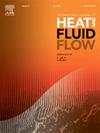Influence of inclined magnetic field on mixed convective cross flow across a cylinder with uniform heat flux condition
IF 2.6
3区 工程技术
Q2 ENGINEERING, MECHANICAL
International Journal of Heat and Fluid Flow
Pub Date : 2024-11-21
DOI:10.1016/j.ijheatfluidflow.2024.109648
引用次数: 0
Abstract
This numerical study delves into the interplay between inclined magnetohydrodynamic flow and mixed convective heat transfer in a cylindrical geometry under uniform heat flux condition. The study employs a quasi-static model, where the fluid is flowing in a cross-stream regime, satisfies the Boussinesq approximation. A higher-order finite difference scheme is adopted to discretize the non-linear Navier–Stokes and energy equations, followed by a stable pseudo-time iterative technique. This study reveals that a lower Richardson number and interaction parameter are sufficient to induce vortex shedding under positive magnetic angles that can not be achieved in case of aligned magnetic field. Increasing the strength of magnetic field tends to restore the symmetric flow structure from the buoyancy-driven asymmetric one, contingent upon the magnetohydrodynamic flow orientations. The coefficients of viscous and pressure drag, average Nusselt number become non-monotonic for the aligned magnetic field, whereas it becomes strictly monotonic for other positive magnetic inclination angles at each Richardson number. Interestingly, increasing magnetic inclination angle allows to augment the total drag coefficient and overall heat transfer drastically. Critical interaction parameter is determined for average Nusselt number at various Richardson and Reynolds numbers under aligned magnetic field. The heat transfer is significantly more enhanced under uniform heat flux condition compared to constant wall temperature condition. The enhanced heat transfer achieved through magnetic field integration and modified thermal conditions has significant potential for applications such as electronic cooling, solar collectors, material processing, and more.
倾斜磁场对均匀热通量条件下圆柱体上混合对流横流的影响
本数值研究深入探讨了在均匀热通量条件下,圆柱几何体中倾斜磁流体与混合对流传热之间的相互作用。研究采用了准静态模型,流体在横流状态下流动,满足布森斯克近似。采用高阶有限差分方案对非线性纳维-斯托克斯方程和能量方程进行离散计算,然后采用稳定的伪时间迭代技术。研究表明,在正磁场角下,较低的理查森数和相互作用参数足以诱发涡旋脱落,而在对齐磁场情况下则无法实现。磁场强度的增加往往会从浮力驱动的非对称流动结构恢复到对称流动结构,这取决于磁流体力学流动方向。对齐磁场的粘性和压力阻力系数、平均努塞尔特数变得不单调,而在每个理查森数下,其他正磁倾角的粘性和压力阻力系数、平均努塞尔特数变得严格单调。有趣的是,增加磁倾角可以大幅提高总阻力系数和总传热。在对齐磁场下,确定了不同理查德森数和雷诺数下平均努塞尔特数的临界相互作用参数。与恒定壁温条件相比,均匀热通量条件下的传热明显更强。通过磁场集成和修改热条件实现的强化传热在电子冷却、太阳能集热器、材料加工等应用中具有巨大潜力。
本文章由计算机程序翻译,如有差异,请以英文原文为准。
求助全文
约1分钟内获得全文
求助全文
来源期刊

International Journal of Heat and Fluid Flow
工程技术-工程:机械
CiteScore
5.00
自引率
7.70%
发文量
131
审稿时长
33 days
期刊介绍:
The International Journal of Heat and Fluid Flow welcomes high-quality original contributions on experimental, computational, and physical aspects of convective heat transfer and fluid dynamics relevant to engineering or the environment, including multiphase and microscale flows.
Papers reporting the application of these disciplines to design and development, with emphasis on new technological fields, are also welcomed. Some of these new fields include microscale electronic and mechanical systems; medical and biological systems; and thermal and flow control in both the internal and external environment.
 求助内容:
求助内容: 应助结果提醒方式:
应助结果提醒方式:


